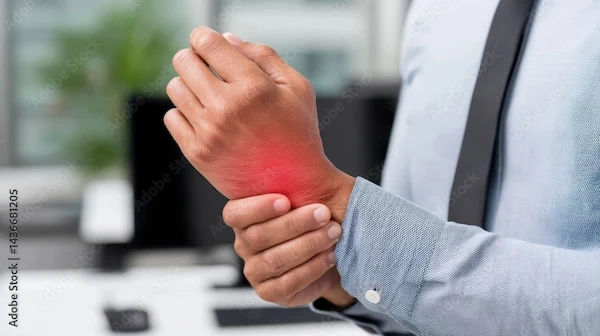Ganglion Cyst: Signs, Causes, and When to See a Doctor
Learn about ganglion cysts, including common signs, causes, and when to seek medical advice. Understand treatment options and how to manage discomfort or complications effectively.

Written by Dr. J T Hema Pratima
Reviewed by Dr. Rohinipriyanka Pondugula MBBS
Last updated on 12th Sep, 2025

Notice a mysterious, sometimes tender, lump on your wrist or hand? You’re likely wondering what it is and if it’s a cause for concern. The most common culprit is a ganglion cyst, a benign, fluid-filled sac that forms near joints and tendons. While often harmless, understanding the signs of a ganglion cyst is the first step toward managing it effectively. This article will demystify this common condition, exploring everything from its tell-tale symptoms and potential causes to the various locations it can appear. We’ll guide you through distinguishing a ganglion from other lumps and, most importantly, advise you on when it’s time to consult a medical professional for a proper diagnosis and personalised care plan.
What Exactly Is a Ganglion Cyst?
A ganglion cyst is a non-cancerous, fluid-filled lump that most commonly develops along the tendons or joints of your wrists or hands, though they can also appear on the ankles and feet. Think of it as a small, balloon-like structure filled with a thick, jelly-like fluid similar to the synovial fluid that lubricates your joints. This key characteristic is what helps doctors differentiate it from other types of growths. Despite their sometimes alarming appearance, ganglion cysts are almost always benign and many cause no symptoms at all other than their visible presence.
The Simple Anatomy of a Ganglion
The cyst itself is a sac that forms from the tissue that surrounds a joint or tendon sheath. It has a stalk that connects it to the joint capsule or tendon sheath, acting like a one-way valve. Joint fluid can flow into the cyst, making it larger, but it has difficulty flowing back out, which is why these cysts can persist and fluctuate in size.
The Most Common Signs and Symptoms of a Ganglion Cyst
Recognising the signs of a ganglion cyst is crucial for peace of mind and determining if treatment is necessary. Symptoms can vary widely from person to person.
The Visible and Palpable Lump
The most obvious sign is the lump itself. It is typically:
Round or Oval: Usually well-defined and symmetrical.
Firm or Spongy: It may feel firm like a bone or have a more rubbery, give-like consistency.
Immobile: The cyst is fixed in place as it is attached to the underlying joint or tendon.
Pain and Discomfort: From Dull Aches to Sharp Pains
Not all cysts are painful. Pain, when it occurs, is often the result of the cyst putting pressure on nearby nerves. This can manifest as:
A constant, dull ache in the joint.
A sharp pain when moving the joint in certain ways.
Tingling or muscle weakness if a nerve is compressed.
How Size and Sensation Can Fluctuate
A unique characteristic of a wrist ganglion cyst is that its size can change. It may grow larger with increased activity that irritates the joint or become smaller with rest. Some people report that the cyst feels tender or sore to the touch, especially when it first appears or during a period of growth.
When a Cyst Causes Functional Problems?
In some cases, particularly with larger cysts, the main issue isn't pain but mechanical interference. A cyst on the back of the wrist can limit how far you can bend it backwards. A ganglion cyst on the foot can make wearing shoes uncomfortable or painful due to constant pressure and rubbing.
Consult Top Specialists
What Leads to a Ganglion Cyst?
The exact cause of a ganglion cyst remains somewhat of a medical mystery. However, doctors and researchers have strong theories based on clinical observation.
The Leading Theory: The predominant theory is that ganglion cysts form due to a flaw in the joint capsule or tendon sheath. Repetitive stress or trauma may cause the tough tissue of the joint capsule to weaken and bulge outward, much like a weak spot on a tire forming a bubble. This bulging tissue then fills with synovial fluid, creating the cyst.
The Role of Repetitive Motion and Microtrauma: Activities that involve repetitive stress on a specific joint are strongly linked to cyst formation. For example, gymnasts who constantly bear weight on their wrists or people who type extensively may be more prone to developing these cysts due to the chronic microtrauma inflicted on the joint.
Previous Injury as a Potential Trigger: A single, significant injury to a joint—such as a sprain or fracture—can damage the joint capsule and initiate the process that leads to a cyst forming weeks, months, or even years later.
Debunking the Myth: It's a common misconception that ganglion cysts are caused by arthritis. While it's true that people with osteoarthritis can develop similar-looking cysts near arthritic joints (called mucous cysts when on the fingers), the typical ganglion cyst on the wrist is not a direct symptom of arthritis. The underlying mechanisms are different.
Where Ganglion Cysts Typically Appear?
These cysts have favourite spots, and their location can influence the symptoms they cause.
The Back of the Wrist (Dorsal Ganglion)
This is the most common location, accounting for 60-70% of all hand and wrist ganglions. They emerge from the scapholunate ligament in the wrist.
The Palm Side of the Wrist (Volar Ganglion)
These are the second most common type. They can be located near the radial artery, which makes treatment more complex due to the risk of vascular injury.
The Base of a Finger (Mucous Cyst)
Appearing at the joint nearest the fingernail (the distal interphalangeal joint), these are often associated with osteoarthritis in that joint. They can cause a groove in the fingernail.
The Foot and Ankle Region
Here, cysts often form on the top of the foot or outside of the ankle. They can be particularly bothersome due to pressure from shoes.
How Are Ganglion Cysts Diagnosed?
Diagnosis is typically straightforward. A doctor will:
The Physical Exam and Transillumination Test: They will press on the lump to assess its size, shape, and tenderness. A classic diagnostic test is transillumination, where the doctor shines a small, bright light against the cyst. A ganglion cyst, being fluid-filled, will typically light up, while a solid mass will not.
The Role of Imaging: Ultrasound and MRI: If the diagnosis is uncertain, an ultrasound can quickly confirm it’s a fluid-filled sac. An MRI may be ordered if the doctor suspects a hidden (occult) ganglion or needs to see the precise relationship of the cyst to nearby nerves and arteries before planning treatment. If you notice a persistent lump, it's wise to get it checked. You can consult a doctor online with Apollo24|7 for an initial evaluation and to determine if you need an in-person visit for imaging.
Conclusion
A ganglion cyst can be a source of anxiety, but understanding its signs and causes is the first step toward addressing it. Remember, the vast majority of these lumps are harmless. While the mystery of their exact origin persists, the connection to joint irritation is clear. The most important thing is not to panic. Monitor the cyst, note any changes in size or sensation, and avoid the old-fashioned (and dangerous) remedy of trying to "pop" it with a heavy book. If your ganglion cyst symptoms—such as persistent pain, numbness, or interference with daily activities—become bothersome, that’s your signal to take action. Booking a physical visit to a doctor with Apollo24|7 ensures you get an accurate diagnosis and can discuss all available management options, from watchful waiting to minimally invasive procedures, tailored to your specific needs.
Consult Top Specialists
Consult Top Specialists

Dr. Vivek Kumar N Savsani
Orthopaedician
8 Years • MBBS, MS Ortho
Bengaluru
Apollo Clinic, JP nagar, Bengaluru

Dr. Manoj Dinkar
Orthopaedician
15 Years • MBBS, Dip (Orthopaedics)
New Delhi
THE DOCTORS NESST, New Delhi

Dr. Bhanu Prakash Reddy Rachamallu
Orthopaedician
24 Years • MBBS , D'ORTHO, DNB (ORTHO), Mch (ORTHO), Fellow in ARTHROPLASTY
Hyderabad
Apollo Hospitals Jubilee Hills, Hyderabad
(75+ Patients)

Dr. Anil Pradeep Jadhav
Orthopaedician
23 Years • MBBS MS (Ortho)
Nashik
Apollo Hospitals Nashik, Nashik
(25+ Patients)

Dr. Keshav Digga
Orthopaedician
14 Years • MBBS, MS Orthopaedics, FIASM, FIMISS
Kolkata
DIGGA HEALTHCARE, Kolkata
More articles from Ganglion Cyst
Frequently Asked Questions
1. Can a ganglion cyst go away on its own?
Yes, it's possible. Many ganglion cysts disappear spontaneously without any treatment. This process can take months or even years.
2. Is a ganglion cyst a sign of cancer?
No. Ganglion cysts are benign (non-cancerous). However, any new, growing, or painful lump should be evaluated by a doctor to rule out other conditions.
3. What happens if a ganglion cyst ruptures?
If a ganglion cyst ruptures, the fluid inside is absorbed by the surrounding tissue. This can cause temporary pain, swelling, and bruising. The cyst may disappear, but it often reforms as the connection to the joint usually remains.
4. What is the main cause of a ganglion cyst?
While the exact cause is unknown, the leading theory is that they form due to a weakness in the joint capsule or tendon sheath, often triggered by repetitive stress, microtrauma, or a previous injury to the joint.
5. What is the fastest way to get rid of a ganglion cyst?
The fastest medical intervention is aspiration, where a doctor drains the fluid with a needle. However, this has a high recurrence rate. Surgical excision (removal) has a lower chance of the cyst returning but involves a longer recovery time. The best approach depends on your individual case.
